TASTE OF ETHIOPIA
Ethiopian Food 101
Top Things To Try
Foods:
- Injera
- Berbere and Mitmita (Spices)
- Doro wat
- Tibs
- Shiro
- Kitfo
- Fit-Fit
Drinks:
- Avocado Juice
- Coffee
 Greetings fellow Chronicfoodie!
Greetings fellow Chronicfoodie!
It was the Summer of 2016 that I found myself basking in the glow of my 50th country visited. It’s hard to imagine that in just 41 years, I had the wonderful privilege of visiting so many countries and experience remarkable moments with people from all corners of the world. That’s why Ethiopia will stand as a very special country for me as it was the 50th in the ever-growing list of countries I’ve had the pleasure of eating through.
My visit to Ethiopia marked my fourth country on the African continent that I had the pleasure of visiting and like the countries before, Ethiopia did not disappoint. Before my visit, I have eaten Ethiopian for several years and remember the first time and how surprised I was with how unique the flavours, smells and textures were compared to cuisine from other African countries. I LOVED IT! And like many African nations, eating with your hands is part of the culture and the experience.
I actually have a theory as to why the food in Ethiopia is so distinct and unique compared to many other countries that are on the African continent: Because they were never colonized, hence, the culinary culture has been preserved and they held onto the flavours of their ancestors. Ethiopians do take great pride that they held off the occupation.
Now, where does one begin??? First, you wash your hands and get your Ethiopian on as your main utensils you’ll be using are the ones you were born with… your hands!
Gursha
Before we talk about the food itself, I want to begin by saying that eating is a very communal experience in Ethiopia. Sharing is so ingrained in the food culture, it essentially is blended together where you can’t have one without the other. Platters are placed between people and the food is then just dug in and consumed. I don’t know all the correct practices nor do I claim to be an expert but I was an excited participant to get my fill on this amazing country and her cuisine. One experience that was a highlight of my time in Ethiopia was being a recipient of a practice called “Gursha”. A practice that is done to honour guests and I had the pleasure of being the only recipient on my food tour which was a delightful honour to receive.
FOODS
Injera
 Before you can start anywhere when it comes to the cuisine of Ethiopia, it has to and ultimately begins with Injera. Injera is eaten at almost every meal and is the quintessential staple amongst Ethiopians. It is a flat, spongy, sourdough tasting kind of bread that often functions as a kind of plate and utensil. The bread is made from an ancient grain called “teff” that has the reputation of being the world’s tiniest grain and one of the earliest known domesticated plant. Depending on who you ask, teff has been grown in the Ethiopia region Before the Common Era (1 B.C.). It’s old and wonderfully healthy!
Before you can start anywhere when it comes to the cuisine of Ethiopia, it has to and ultimately begins with Injera. Injera is eaten at almost every meal and is the quintessential staple amongst Ethiopians. It is a flat, spongy, sourdough tasting kind of bread that often functions as a kind of plate and utensil. The bread is made from an ancient grain called “teff” that has the reputation of being the world’s tiniest grain and one of the earliest known domesticated plant. Depending on who you ask, teff has been grown in the Ethiopia region Before the Common Era (1 B.C.). It’s old and wonderfully healthy!
Making Injera is not easy as it may appear at first. When the batter is made, you have to pour it on a round skillet type top and swirl around evenly. It takes some practice but of course, I had to take a stab at it and sadly, it did not go well.
Berbere and Mitmita (Spices)
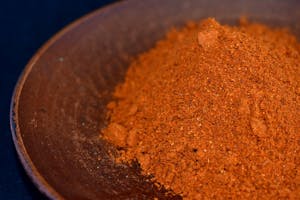 Berbere is the Ethiopian spice mix that has similarities to “masala” in India but make no mistake, this spice mix is authentically Ethiopian and is almost as foundational to the cuisine as injera. The traditional mix includes chilli peppers, garlic, ginger, basil, korarima, rue, ajwain or radhuni, nigella, and fenugreek.
Berbere is the Ethiopian spice mix that has similarities to “masala” in India but make no mistake, this spice mix is authentically Ethiopian and is almost as foundational to the cuisine as injera. The traditional mix includes chilli peppers, garlic, ginger, basil, korarima, rue, ajwain or radhuni, nigella, and fenugreek.
 I should note that Ethiopians like their food spicy and the main source of their heat comes from Berbere but if you are looking to kick it even higher, then you need to add Mitmita which is also a spice mix. Lighter in colour but packs quite a punch so definitely not for the faint of heart. I’ve had Ethiopian with both spices added to the dish but I always ask for a side of it to dip my food in to give it a more favourable kick. I have only known mitmita to be given as a powder mix rather than a sauce as I’m accustomed to in other cuisines and don’t be shy to ask for more if needed.
I should note that Ethiopians like their food spicy and the main source of their heat comes from Berbere but if you are looking to kick it even higher, then you need to add Mitmita which is also a spice mix. Lighter in colour but packs quite a punch so definitely not for the faint of heart. I’ve had Ethiopian with both spices added to the dish but I always ask for a side of it to dip my food in to give it a more favourable kick. I have only known mitmita to be given as a powder mix rather than a sauce as I’m accustomed to in other cuisines and don’t be shy to ask for more if needed.
Doro Wat
 “Wat” is essentially a stew or curry. Doro Wat is an Ethiopian chicken stew/curry and one of the most popular dishes in Ethiopia and some say all of Africa. This spicy chicken stew is so full of flavour, it is a celebration of tastes in the mouth but as with most dishes, this does have a kick. In my experience, it always seems to come with a hard boiled egg and I love it whenever any dish tries to put an egg into the mix. Wat can also be with beef or lamb and I’ve had all versions and all are quite delicious!
“Wat” is essentially a stew or curry. Doro Wat is an Ethiopian chicken stew/curry and one of the most popular dishes in Ethiopia and some say all of Africa. This spicy chicken stew is so full of flavour, it is a celebration of tastes in the mouth but as with most dishes, this does have a kick. In my experience, it always seems to come with a hard boiled egg and I love it whenever any dish tries to put an egg into the mix. Wat can also be with beef or lamb and I’ve had all versions and all are quite delicious!
Tibs
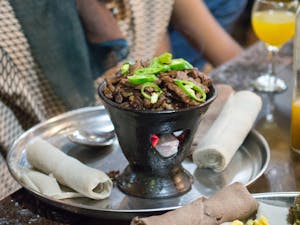
Tibs in Yod Abyssinia, Addis Ababa, Ethiopia
A favourite amongst anyone who loves meat and Ethiopians do love their meats. I’ve been to Ethiopia and I’ve eaten tibs in a couple of restaurants in Toronto and the variety of flavours and how it is prepared can vary quite a bit. Beef is probably the most common but my personal favourite is lamb or mutton. One of the ways that tibs is served reminds me of how Korean meats are sometimes served; on a hot plate or bowl. Cooked with Ethiopian butter along with spices and herbs, this pan-fried dish is a delicious way to get varied texture from the vegetable dishes you will have at a meal.

Don’t forget the awaze sauce/paste which is wonderfully designed to eat with tibs. A mix of berbere, garlic and wine, it is a deep, dark, spicy paste that can be used for dipping.
Bayenetu
Ethiopians are known to be quite religious where almost half are Orthodox and they have essentially a vegan diet for close to 50% of the calendar year. This is probably why Ethiopian cuisine has been a favourite amongst vegans and like many countries that have culture and religion that omits meat from their diet, they will have the best vegetarian cuisine. In my experience, religion is often one of the most defining influences in cuisine all around the world and the creativity of what people are able to do with what their land can provide is always fascinating to me and so glad that I can experience what the results can produce.
 Think of Beyenetu as a “veggie platter” where you have a variety of vegetable dishes served wonderfully on a bed of injera. The variety of dishes can be broad but in my experience, there is no shortage of lentils, chickpeas and cabbage but of course, it is all eaten with injera! If you’re a bit nervous about the spice being too hot, veggie options are a generally safe way to go but do ask as some do have a kick that may surprise. A vegetarian/ vegan-friendly way of experiencing the flavours of Ethiopia and to get a taste for what meals would be like during the fasting days.
Think of Beyenetu as a “veggie platter” where you have a variety of vegetable dishes served wonderfully on a bed of injera. The variety of dishes can be broad but in my experience, there is no shortage of lentils, chickpeas and cabbage but of course, it is all eaten with injera! If you’re a bit nervous about the spice being too hot, veggie options are a generally safe way to go but do ask as some do have a kick that may surprise. A vegetarian/ vegan-friendly way of experiencing the flavours of Ethiopia and to get a taste for what meals would be like during the fasting days.
Shiro
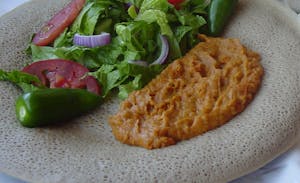 Shiro is a staple during the fasting days where this delicious chickpea dish is always on the menu and I’ve never had an Ethiopian dinner without it. A quick description of it is like spicy, chunky hummus served hot. Or a smoother version of chana masala. I can eat this every day without blinking and a guaranteed addition with any veggie platter you order at an Ethiopian restaurant.
Shiro is a staple during the fasting days where this delicious chickpea dish is always on the menu and I’ve never had an Ethiopian dinner without it. A quick description of it is like spicy, chunky hummus served hot. Or a smoother version of chana masala. I can eat this every day without blinking and a guaranteed addition with any veggie platter you order at an Ethiopian restaurant.
Kitfo – (For the more adventurous)
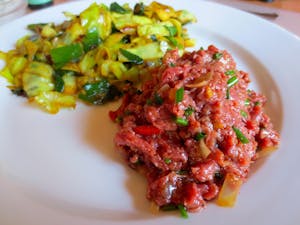 Not something for everyone, especially if the thought of steak tartare is not on your menu of things to try. Kitfo is a popular dish, especially amongst men and a sought-after dish on Easter Sunday after they have been on a vegan diet for over a month. This raw meat dish looks no different than French steak tartare where raw ox-meat is spiced up and eaten raw. Definitely not for everyone but for those who can get over the fact that it is raw meat, it is absolutely delicious and when done right, the meat will be smooth like butter!
Not something for everyone, especially if the thought of steak tartare is not on your menu of things to try. Kitfo is a popular dish, especially amongst men and a sought-after dish on Easter Sunday after they have been on a vegan diet for over a month. This raw meat dish looks no different than French steak tartare where raw ox-meat is spiced up and eaten raw. Definitely not for everyone but for those who can get over the fact that it is raw meat, it is absolutely delicious and when done right, the meat will be smooth like butter!
Fit-Fit (aka fir-fir)
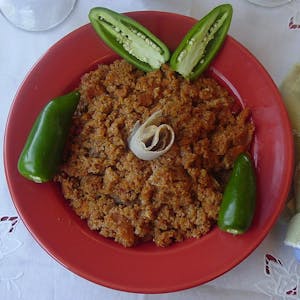 If you’re looking for a breakfast that will get you up in the morning, fit-fit will definitely do the trick. It’s not complicated but a great way to start your morning. This spicy bowl of chopped injera where the kick is brought with the berbere spice mix can be made in a large number of ways where people can add shiro but there is a version called kitcha fit-fit where they add pieces of a wheat-based flatbread commonly eaten in Ethiopia. Did I mention that Ethiopians like their food spicy?!?!
If you’re looking for a breakfast that will get you up in the morning, fit-fit will definitely do the trick. It’s not complicated but a great way to start your morning. This spicy bowl of chopped injera where the kick is brought with the berbere spice mix can be made in a large number of ways where people can add shiro but there is a version called kitcha fit-fit where they add pieces of a wheat-based flatbread commonly eaten in Ethiopia. Did I mention that Ethiopians like their food spicy?!?!
DRINKS
Avocado Juice
Brought over from Central America, Ethiopians have really adopted the avocado as a crop to grow and export. You really don’t see it in the cuisine but I certainly saw it all over the place where they have it as a beverage. On my food tour in Ethiopia, we made a stop at a juice shop where I got myself a unique juice where they had several fruit juices (very thick) along with blended avocado. It was delicious and a great compliment to have when you’re chowing down on some really spicy eats.
Coffee
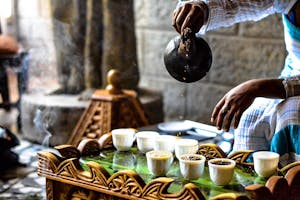 There is a belief that coffee had its origins in Ethiopia and although they don’t have solid proof, they do have a compelling argument that this bean that has taken the world over was first harvested and consumed in this African nation back in the 14th century. The importance of coffee in Ethiopia is hard to miss and participating in an Ethiopian coffee ceremony is something that everyone needs to experience. I drank so much coffee in Ethiopia that I can’t remember if I actually slept that much during my visit. It’s an elaborate process but the ritual is a wonderful way to take some time in the day to spend with friends and loved ones and to enjoy a cup of delicious, freshly roasted and brewed Ethiopian coffee.
There is a belief that coffee had its origins in Ethiopia and although they don’t have solid proof, they do have a compelling argument that this bean that has taken the world over was first harvested and consumed in this African nation back in the 14th century. The importance of coffee in Ethiopia is hard to miss and participating in an Ethiopian coffee ceremony is something that everyone needs to experience. I drank so much coffee in Ethiopia that I can’t remember if I actually slept that much during my visit. It’s an elaborate process but the ritual is a wonderful way to take some time in the day to spend with friends and loved ones and to enjoy a cup of delicious, freshly roasted and brewed Ethiopian coffee.
A common practice in the ceremony is the burning of incense and most notably, frankincense, and the coffee can be stirred with Adam leaves. Depending on where you are in Ethiopia, you can have coffee served with sugar but not unusual, especially outside of the city, they will serve it with salt and/or butter. I did it with the butter while in Addis Ababa complimented with sweetened popcorn which is also customary to have at a coffee ceremony.
Conclusion
There you have it… I could not have been more thrilled to have had the chance to visit Ethiopia and to discover the flavours I first got introduced to in Toronto. There is something special about Ethiopia. Perhaps it was the history that surrounded me or the amazing people I had the pleasure of meeting or perhaps it was simply because Ethiopia welcomed me with open arms and made me feel at home. I’ve now been to 4 African countries and this one certainly didn’t disappoint and can’t wait to return for more delicious eats!
Till next time… Stay Hungry!
Yours,
Chronicfoodie
